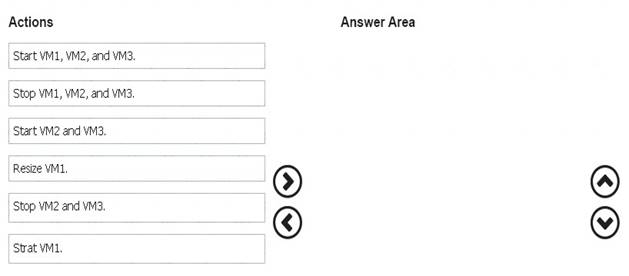Question 79
- (Exam Topic 4)
You have an Azure virtual network named VNet1 that connects to your on-premises network by using a site-to-site VPN. VMet1 contains one subnet named Subnet1.
Subnet1 is associated to a network security group (NSG) named NSG1. Subnet1 contains a basic internal load balancer named ILB1. ILB1 has three Azure virtual machines in the backend pool.
You need to collect data about the IP addresses that connects to ILB1. You must be able to run interactive queries from the Azure portal against the collected data.
What should you do? To answer, select the appropriate options in the answer area. NOTE: Each correct selection is worth one point.
Solution:
Box 1: An Azure Log Analytics workspace
In the Azure portal you can set up a Log Analytics workspace, which is a unique Log Analytics environment with its own data repository, data sources, and solutions
Box 2: ILB1
References:
https://docs.microsoft.com/en-us/azure/log-analytics/log-analytics-quick-create-workspace
https://docs.microsoft.com/en-us/azure/load-balancer/load-balancer-standard-diagnostics
Does this meet the goal?
Correct Answer:A
Question 80
- (Exam Topic 6)
You have an availability set named AS1 that contains three virtual machines named VM1, VM2, and VM3. You attempt to reconfigure VM1 to use a larger size. The operation fails and you receive an allocation failure message.
You need to ensure that the resize operation succeeds.
Which three actions should you perform in sequence? To answer, move the appropriate actions from the list of actions to the answer area and arrange them in the correct order.
Solution:
Action 1: Stop VM1, VM2 and VM3
If the VM you wish to resize is part of an availability set, then you must stop all VMs in the availability set before changing the size of any VM in the availability set. The reason all VMs in the availability set must be stopped before performing the resize operation to a size that requires different hardware is that all running VMs in the availability set must be using the same physical hardware cluster. Therefore, if a change of physical hardware cluster is required to change the VM size then all VMs must be first stopped and then restarted one-by-one to a different physical hardware clusters.
Action 2: Resize VM1
Action 3: Start VM1, VM2, and VM3 References:
https://azure.microsoft.com/es-es/blog/resize-virtual-machines/
Does this meet the goal?
Correct Answer:A
Question 81
- (Exam Topic 6)
Note: This question is part of a series of questions that present the same scenario. Each question in the series contains a unique solution that might meet the stated goals. Some question sets might have more than one correct solution, while others might not have a correct solution.
After you answer a question in this section, you will NOT be able to return to it. As a result, these questions will not appear in the review screen.
You need to ensure that an Azure Active Directory (Azure AD) user named Admin1 is assigned the required role to enable Traffic Analytics for an Azure subscription.
Solution: You assign the Owner role at the subscription level to Admin1. Does this meet the goal?
Correct Answer:A
Your account must meet one of the following to enable traffic analytics:
Your account must have any one of the following Azure roles at the subscription scope: owner, contributor, reader, or network contributor.
Reference:
https://docs.microsoft.com/en-us/azure/network-watcher/traffic-analytics-faq
Question 82
- (Exam Topic 6)
You have an Azure subscription named Subscription1.
You plan to deploy an Ubuntu Server virtual machine named VM1 to Subscription1.
You need to perform a custom deployment of the virtual machine. A specific trusted root certification authority (CA) must be added during the deployment.
What should you do? To answer, select the appropriate options in the answer area. NOTE: Each correct selection is worth one point.
Solution:
Box 1: Cloud-init.txt
Cloud-init.txt is used to customize a Linux VM on first boot up. It can be used to install packages and write files, or to configure users and security. No additional steps or agents are required to apply your configuration.
Box 2: The az vm create command
Once Cloud-init.txt has been created, you can deploy the VM with az vm create cmdlet, sing the --customdata parameter to provide the full path to the cloud-init.txt file.
References:
https://docs.microsoft.com/en-us/azure/virtual-machines/linux/tutorial-automate-vm-deployment
Does this meet the goal?
Correct Answer:A
Question 83
- (Exam Topic 6)
You have an Azure subscription that contains the identifies shown in the following table.
User1, Principle, and Group1 are assigned the Monitoring Reader role. An action an alert rule named Alert1 that uses AG1.
You need to identify who will receive an email notification when Alert1 is triggered. Who should you identity?
Correct Answer:C
Email will only be sent to Azure AD user members of the Monitoring Reader role. Email will not be sent to Azure AD groups or service principals.
Reference:
https://docs.microsoft.com/en-us/azure/azure-monitor/platform/action-groups
Question 84
- (Exam Topic 6)
You are deploying a containerized web application in Azure.
When deploying the web app, which of the following are valid container image sources?
Correct Answer:BC
When you create a web app from a Docker image, you configure the following properties:
T· he registry
that contains the image. The registry can bDe ocker Hub, Azure Container Registry (ACR),
or some other private registry.
· The image :This item is the name of the repository.
· The tag : This item indicates which version of the image to use from the repository. By convention, the recent version is given the tag latest when it's built.
· Startup File :This item is the name of an executable file or a command to be run when the image is loaded. It's equivalent to the command that you can supply to Docker when running an image from the command line by using docker run. If you're deploying a ready-to-run, containerized app that already has the ENTRYPOINT
and/or COMMAND values configured, you don't need to fill this in. ence:
https://docs.microsoft.com/en-us/learn/modules/deploy-run-container-app-service/4-deploy-web-app